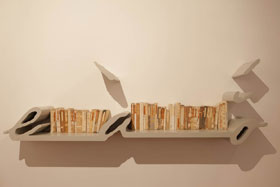The Courage of Provocation

Work by ARC (Archive and Curation) MA students, Andrew Putter and George Mahashe, as well as an essay by APC's former post-doc, Kylie Thomas, was featured in Kronos: Southern African Histories, 38, a special issue on documentary photography
John Wright
The conference, The Courageof ||kabbo and a Century of Specimens of Bushman Folklore, was organised by Pippa Skotnes, Professor of Fine Art at the University of Cape Town, and Doctor Janette Deacon, Honorary Research Associate of the Rock Art Research Institute at the University of the Witwatersrand, to mark the hundredth anniversary of the publication in 1911 of Specimens of Bushman Folklore.
This book has long been known to students of ethnography and has in recent years been widely taken up by students of rock art as well. It puts into print a selection of texts in the /xam language, together with parallel translations in English, collected in Cape Town from /xam interlocutors by the philologist Wilhelm Bleek and his sister-in-law, Lucy Lloyd in the period 1870-1875, and then, after Bleek's death, by Lloyd in the later 1870s and early 1880s.
The conference, which was held at the Hiddingh campus of the University of Cape Town, was in effect the latest in a series of celebrations - in the form of conferences, exhibitions, and publications - of the work of Bleek and Lloyd that have been held in the city in recent years. It brought together academics from southern Africa, Germany, Spain, the USA and the UK, invited members of Khoisan communities, and an audience of several hundred members of the public.
Some thirty academic papers were presented. One category consisted of papers that focused on issues relating to the nature of archive, and the processes in which collections of manuscripts and books are made and curated. Another focussed on questions of story-telling and translation; a third on the Bleek-Lloyd collection as a source of ethnographic information; a fourth on Khoisan linguistics; a fifth on issues of history and 'Bushman' identity.
Five members of the Archive and Public Culture Research Initiative presented papers: José Manuel de Prada-Samper ('"The pictures of the /xam people are in their bodies": presentiments, landscape and rock art in //xabbo's country'); Carolyn Hamilton ('The life of the archive'); Hedley Twidle, ('From "The origins of language" to a language of origin: A prologue to the Grey Collection'); Jill Weintroub, ('The rock art and linguistic researches of Dorothea Bleek'); and Marlene Winberg, ('Silent children of the archive: Reading Lucy Lloyd and the !kun boys' visual archive (1879-1881)'). I also chaired one of the sessions. And, to round off the first day, a celebration was held to mark the publication of a new book by Jill Weintroub; By Small Wagon with Full Tent, Dorothea Bleek's Journey to Kakia, June to August 1913 [See separate report].
This historian came away from the conference with mixed feelings. The first day I found rather stifling, with two potentially exciting papers by Hamilton and Hofmeyr on the historicity of archive getting rather lost in a succession of papers which, with one or two exceptions, seemed to me to be saying nothing really new, and in the process tending to reduce the Bleek and Lloyd texts to little more than a source of ethnographic detail.
The second day was, for me, much more interesting, with a number of stimulating papers on the Khoisan languages pointing to the potential of linguistic studies as a source of historical information available nowhere else.
On the final day, two provocative inputs from Sven Ouzman ('Bushman specimens: the hidden lives of objects') and Anne Solomon ('"People who are different": alterity and the /xam texts') provided the kind of critical perspectives that were by and large not enough in evidence at the conference. Overall, it seems to me, the Bleek and Lloyd collection has had enough of an airing for a while; it is time for scholars in this field to turn their attention to critical and explicitly historicised examinations of the great body of ethnographic and linguistic texts on KhoeSan groups that has been produced in South Africa, Botswana and Namibia since the time of these pioneering researchers.
Professor John Wright is a researcher with the Rock Art Research Institute at the University of the Witwatersrand and an Honorary Research Fellow with the Archive and Public Culture research initiative.